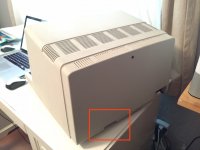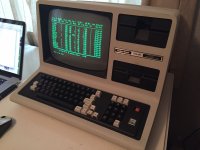mykrowyre
Experienced Member
I have a model 4 gate array I just purchased which had a HXC2001 floppy emulator installed and the floppies removed. I came with a pile of disk drives.
It tries to boot from SD card but I didn't have a valid config file so it complains. I removed the floppy emulator so I could re-install the original floppy drives.
I have a pile of 6 original floppy drives, all single sided, none have terminating resistors.
The original floppy cable is the one with pins removed to activate only 10 and 12 for drive 0 and 1 so terminating resistors are not required.
Of the 6 drives, one of them will give a "Diskette?" prompt when installed alone at the end of the cable.
If I insert a disk and reset, it will boot but the display will suddenly tear as if it's lost sync, but I can see activity as the machine boots and text is printed. I see more torn lines appearing as I hit enter.
For the other floppy drives, none of them give me a "Diskette?" prompt. Instead I get a black screen. They will still boot on reset resulting in the same screen tearing.
If I power on holding the break key, I get a cassette basic prompt even if I get the black screen initially.
I am booting from a CP/M disk it's all I have.
So my question is: Is CP/M trying to boot in 80 col mode which is causing the monitor to lose sync due to another issue?
What would prevent the machine from displaying "Diskette?" when I install any of the other 5 disk drives?
At first I thought the drives had bad caps and were pulling down the power rails, but resetting with break key held gets me into basic with a clear screen so that doesn't seem to be the case. Could I simply have a bad floppy cable?
Any ideas?
Thanks
It tries to boot from SD card but I didn't have a valid config file so it complains. I removed the floppy emulator so I could re-install the original floppy drives.
I have a pile of 6 original floppy drives, all single sided, none have terminating resistors.
The original floppy cable is the one with pins removed to activate only 10 and 12 for drive 0 and 1 so terminating resistors are not required.
Of the 6 drives, one of them will give a "Diskette?" prompt when installed alone at the end of the cable.
If I insert a disk and reset, it will boot but the display will suddenly tear as if it's lost sync, but I can see activity as the machine boots and text is printed. I see more torn lines appearing as I hit enter.
For the other floppy drives, none of them give me a "Diskette?" prompt. Instead I get a black screen. They will still boot on reset resulting in the same screen tearing.
If I power on holding the break key, I get a cassette basic prompt even if I get the black screen initially.
I am booting from a CP/M disk it's all I have.
So my question is: Is CP/M trying to boot in 80 col mode which is causing the monitor to lose sync due to another issue?
What would prevent the machine from displaying "Diskette?" when I install any of the other 5 disk drives?
At first I thought the drives had bad caps and were pulling down the power rails, but resetting with break key held gets me into basic with a clear screen so that doesn't seem to be the case. Could I simply have a bad floppy cable?
Any ideas?
Thanks


